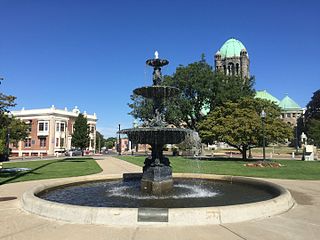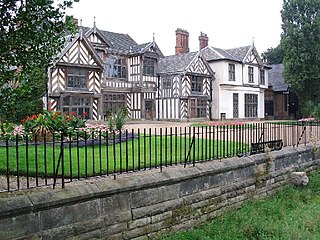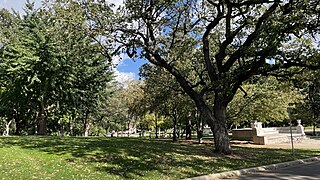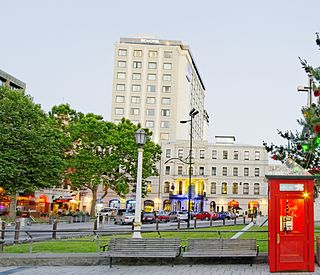
Taunton is a city and county seat of Bristol County, Massachusetts, United States. Taunton is situated on the Taunton River, which winds its way through the city on its way to Mount Hope Bay, 10 miles (16 km) to the south. At the 2020 census, the city had a population of 59,408. Shaunna O'Connell is the mayor of Taunton.

Wythenshawe Hall is a 16th-century timber-framed historic house and former manor house in Wythenshawe, Manchester, England, 5 miles (8.0 km) south of Manchester city centre in Wythenshawe Park. Built for Robert Tatton, it was home to the Tatton family for almost 400 years. Its basic plan is a central hall with two projecting wings.

The Royal Exhibition Building is a UNESCO World Heritage-listed building in Melbourne, Victoria, Australia, built in 1879–1880 as part of the international exhibition movement, which presented over 50 exhibitions between 1851 and 1915 around the globe. The building sits on approximately 26 hectares, is 150 metres (490 ft) long and is surrounded by four city streets. It is situated at 9 Nicholson Street in the Carlton Gardens, flanked by Victoria, Carlton and Rathdowne Streets, at the north-eastern edge of the central business district. It was built to host the Melbourne International Exhibition in 1880–81, and then hosted the even larger Centennial International Exhibition in 1888. It was then chosen as the site for the Federation of the Commonwealth of Australia in 1901. The building is representative of the financial wealth and pride that the city of Melbourne and state of Victoria had in the 1870s. Throughout the 20th century smaller sections and wings of the building were subject to demolition and fire; however, the main building, known as the Great Hall, survived.

Massey Hall is a performing arts theatre in Toronto, Ontario, Canada. Opened in 1894, it is known for its outstanding acoustics and was the long-time hall of the Toronto Symphony Orchestra. An intimate theatre, it was originally designed to seat 3,500 patrons, but after extensive renovations in the 1940s, it now seats only up to 2,765. It has an extensive history of concerts by artists of many musical genres which continues today.

Dixie Square Mall was an enclosed shopping mall at the junction of 151st Street and Dixie Highway in the Chicago suburb of Harvey, Illinois, United States. Opened in 1966, the mall featured Montgomery Ward, JCPenney, Woolworth, Walgreens, and Jewel as its anchor stores, with discount store Turn Style joining in 1970. The mall was in operation for twelve years, closing permanently in 1978. It is thus considered an early example of a dead mall; it was characterized by high vacancy rates and low patronage, which led to its closure. While many other dead malls were redeveloped or demolished, Dixie Square became notable for its extensive neglect, vandalism damage, and history. After closure, the mall was used for a scene in the film The Blues Brothers and then left abandoned. It achieved notoriety because of a growing Internet cult-following of urban exploration groups dedicated to covering the mall's deteriorating condition.

Taunton High School is located within a large, three-floor, interconnected, multi-block complex in the eastern section of Taunton, Massachusetts, United States. It is an urban public high school with an estimated average student enrollment of 3,000 students. It offers many student-oriented services, specialty academic programs, extra-curricular clubs, various after-school programs and a wide array of scholastic sports. Taunton High School is one of the largest high schools in New England, and is the 4th largest in Massachusetts, behind Brockton, Lowell, and New Bedford.

Taunton State Hospital is a psychiatric hospital located on Hodges Avenue in Taunton, Massachusetts. Established in 1854, it was originally known as the State Lunatic Hospital at Taunton. It was the second state asylum in Massachusetts. Most of the original part of the facility was built in a unique and rare neo-classical style designed by architects Boyden & Ball. It is also a Kirkbride Plan hospital and is located on a large 154-acre (62 ha) farm along the Mill River.

The New Orleans Public Library (NOPL) is the public library of the city of New Orleans, Louisiana, United States. Succeeding earlier libraries in the city, it opened in 1897. Three branches were added by 1908. Carnegie library branches were added in 1911 and 1915. By 2005 a dozen branches were open. The main library is listed on the National Register of Historic Places.

Madison Theatre is a historic theater in Peoria, Illinois, United States that opened on October 16, 1920, as a silent picture theatre.

The Ogle County Courthouse is a National Register of Historic Places listing in the Ogle County, Illinois, county seat of Oregon. The building stands on a public square in the city's downtown commercial district. The current structure was completed in 1891 and was preceded by two other buildings, one of which was destroyed by a group of outlaws. Following the destruction of the courthouse, the county was without a judicial building for a period during the 1840s. The Ogle County Courthouse was designed by Chicago architect George O. Garnsey in the Romanesque Revival style of architecture. The ridged roof is dominated by its wooden cupola which stands out at a distance.

The University of Minnesota Old Campus Historic District is a historic district located in Minneapolis, Minnesota. Listed in the National Register of Historic Places since 1984, it includes a number of historic buildings that were constructed during the late 1800s and early 1900s, and represents the oldest extant section of the University of Minnesota campus. The general area was designed by landscape architect Horace W. S. Cleveland, who envisioned a park-like University. His plan, that he presented to the Board of Regents, went on to help form the Historic District. It is located directly to the north of the University's Northrop Mall Historic District.

Miller Symphony Hall is a 1,100-seat performing arts facility in Allentown, Pennsylvania that hosts the Allentown Symphony Orchestra. The hall was previously known as Central Market (1896), Lyric Theater (1899), and Allentown Symphony Hall (1959). In 2012, it was renamed for the Miller family, longtime owners of the hall and of The Morning Call newspaper.
The Paul A. Dever State School, also known as the Myles Standish School for the Mentally Retarded is a former state school located in Taunton, Massachusetts, at the former site of Camp Myles Standish. It was turned into a school for the mentally disabled in 1959. At this time, the name was changed to the Paul A. Dever State School, after the Governor of the Commonwealth of Massachusetts from 1949–1953, Paul A. Dever.

Elbridge Boyden (1810–1898) was a prominent 19th-century American architect from Worcester, Massachusetts, who designed numerous civil and public buildings throughout New England and other parts of the United States. Perhaps his best known works are the Taunton State Hospital (1851) and Mechanics Hall (1855) in Worcester.

Northfield Manor House is a Manor House, on Bristol Road South, Northfield, Birmingham, England. It was formerly known as Manor Farm, and under that name was home to George and Elizabeth Cadbury.

Warner's Hotel in 50 Cathedral Square, Christchurch is the site of a hotel established in 1863. The original building, extended on numerous occasions, burned down in 1900. A new building was built in 1901. Again, it underwent numerous alterations. A fourth storey was added in 1910 and the northern end of the building was demolished in 1917 and a theatre built in its place to create a noise buffer to the printing presses of the adjoining Lyttelton Times Building. The theatre was demolished in 1996 and patrons enjoyed a beer garden. In 2010, a high-rise Novotel hotel opened on the site of the beer garden and in the process, the historical and symmetrical 1901 façade was recreated.

Calgary City Hall, is the seat of government for Calgary City Council, located in the city's downtown core of Calgary, Alberta, Canada. The historic building completed in 1911 serves as the offices for Calgary City Council, consisting of the office of the Mayor, fourteen Councillors and municipal Clerk. Calgary City Hall originally housed the municipal council and portions of administration from its completion in 1911 until the construction of the Calgary Municipal Building adjacent to Old City Hall in 1985, which currently houses the offices of 2,000 civic administrators.

The Mayfair Theatre, also known as the Auditorium Theatre and Auditorium Music Hall, is a historic theatre site in Baltimore, United States. Originally opened in 1880 as a bathing house, the site was later demolished and rebuilt in 1904 as a theatre, which was closed in 1986.
A fire at Star City, an amusement park in Pasay, Metro Manila, Philippines, occurred at midnight on October 2, 2019. Initial investigation determined the cause as arson, citing traces of gasoline detected in the remains of the building. In December 2019, however, the cause was confirmed as an electrical fire which originated from a game booth on Star City's ground floor. Although there were no reported casualties, 80 per cent of the establishment was confirmed to have been damaged by the fire, the cost of which was estimated to be ₱1 billion. The management of Star City announced that it would engage in a year-long rehabilitation effort before reopening the amusement park.

The State Theatre is a historic one-screen movie theater in Sioux Falls, South Dakota. Opened in 1926, it operated continuously until 1990 when it was closed amidst the popularity of multiplexes. In 2005, a city-supported group was formed to finance the renovation and re-opening of the venue. In December 2020, the State Theatre resumed screening movies. The historic building was designed by Buechner & Orth, an architecture firm from Saint Paul, Minnesota.






















